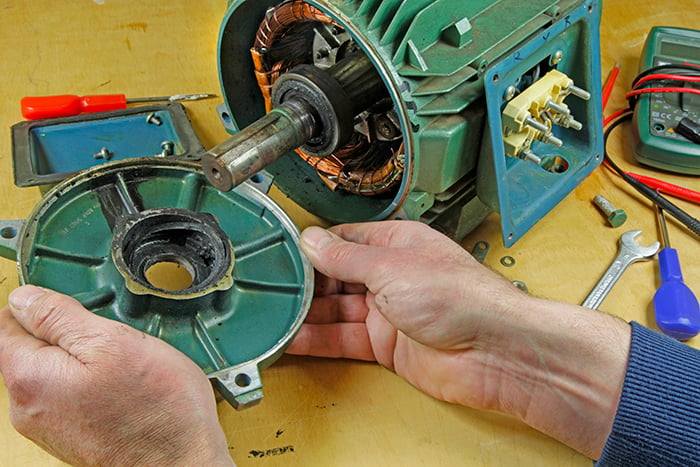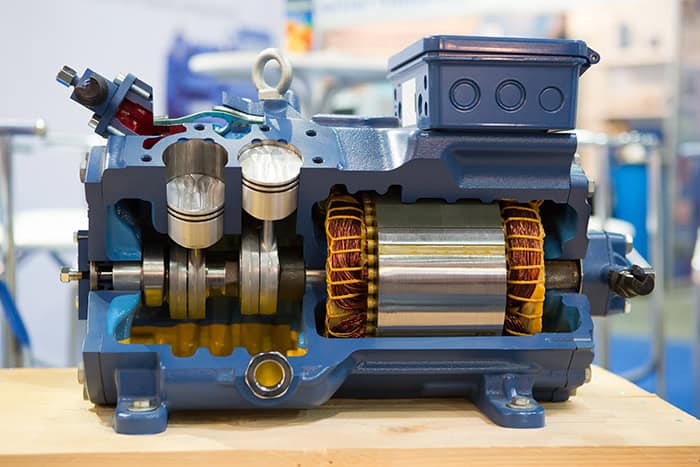Though some historians trace the history of the motor back to 13th century Chinese weaponry, motors didn’t commonly exist in the West until the 18th century. The electric motor is an even newer invention, and today it serves as a valuable industrial component in many diverse fields.
In this article, we will describe what makes up an electric motor, the most popular kinds of electric motors, what you might need to know prior to buying an electric motor, and how you can find one on Surplus Record.
Components of Electric Motors

At its most basic level, a motor converts some kind of energy into mechanical energy. An electric motor uses electrical energy to do so. Electrical motors contain the following parts.
- Stator. A stationary part of the motor that contains a magnet of some kind. The exact components of the stator will depend on whether the motor is an AC motor or a DC motor, but both will contain wires wound about a ferromagnetic iron core.
- Rotor. A movable section connected to a shaft, the rotor carries an electromagnetic current that allows it to turn, thus transforming electrical energy into mechanical energy.
- Commutator. Used in DC motors, commutators help maintain repulsion between the rotor and the stator, serving as a kind of rotary electrical switch.
- Bearings. These supportive structures bear up the rotor, allowing it to freely turn within designed tolerances and extend beyond the motor’s casing to where it can freely spin, generating mechanical energy.
- Windings. Wires wrapped into coils around a magnetic core of some kind, windings generate magnetic force when electrified and cause the rotor to spin.
- Insulation. Most electric motors contain insulation that helps protect the interior of the motor from dirt and damage.
- Casing. The motor casing supports the internals of an electric motor and helps protect them from physical shocks.
Popular Types of Electric Motors
Electric motors fall into one of two broad categories: DC motors and AC motors.
DC (direct current) motors are the oldest type of electric motor and draw their power from direct current electricity. They can be fitted with permanent magnets (e.g., brushless motors) or contain brushes that help generate magnetic forces (e.g., brushed motors).
AC (alternating current) motors use electricity that, appropriately enough, alternates at either 50Hz or 60Hz. (AC in the United States runs at 60Hz.) AC motors generally always use permanent magnets.
In addition to these most basic categories, you will find several other kinds of electric motors, some of which correspond to one electrical type and some of which apply to both. These include:
Direct Drive Motors
These are any kind of motor that doesn’t use mechanical transmission intermediaries and are instead connected directly to a load.
Linear Motors
Due to the unique arrangement of the stator and the rotor, linear motors produce linear force rather than the traditional rotational force.
Servo Motors
A wide designation, servo motors include any kind of motor that’s paired with positioning sensors.
Stepper Motors
These motors feature an internal rotor that is spun by externally arranged magnets.
Compound Motors
These DC motors combine efficiently regulated speed with high starting torque.
Induction Motors
These kinds of AC motors generate the electrical current necessary to create torque through the stator winding and do not require electrical connections to the rotor.
Brushless Motors
This class of DC motor is also known as a synchronous motor and generates rotational force by combining a permanent magnet with variably charged wound magnets. These motors require less maintenance and enjoy a high power-to-weight ratio.
Hysteresis Motors
A kind of of synchronous motor, hysteresis motors rely on a lag in magnetic force to keep the motor turning. In the context of magnetism, hysteresis means the tendency of a ferromagnet to remain magnetized even after an electric field is removed.
Reluctance Motors
These sorts of synchronous motors function by employing the magnetic resistance (i.e., reluctance) of the rotor magnets with the stator. While these are the cheapest types of synchronous motors, they also typically have lower efficiencies and torques.
Universal Motors
These sorts of motors will function equally well on either AC or DC power. However, they tend to have shorter operational lives and require more maintenance than other types.
What to Look for When Buying an Electric Motor

Prior to purchasing an electric motor, you should consider several factors first. Failing to address any of these could leave you with an only marginally effective motor — or one that won’t work at all for you. Important factors include:
Spatial Restrictions. The first step potential purchasers should take is to compare the spatial requirements for their end-use scenario with their preferred motors. It may be that the space available precludes certain available options.
Efficiency. The true cost of an electric motor isn’t its purchase price, but rather its purchase price combined with the cost of operation. A seemingly “cheap” motor might prove quite expensive if run for long periods. Similarly, a highly efficient motor that only needs to function intermittently might not be worth the premium it commands.
Maintenance / Life Cycle. No motor lasts forever, and many kinds of motors require regular maintenance to function properly. Consider DC motors that must have their brushes serviced or replaced.
Setting. What’s the setting in which your electric motor will operate like? How warm or cold will it be? Will you have to account for particulate matter, dust, dirt, water, or other potential contaminants? Positive or negative answers to these questions will help you narrow down an appropriate motor.
Noise and Ventilation Restrictions. Similar to the above point, ventilation requirements and noise thresholds will also impact what kinds of motor will work with your end-use application.
Motor-Specific Technical Specifications. Every motor will have different specifications and requirements for voltage, frequency, speed, torque, and power.
How to Calculate the Motor Size for Your Project
Calculating the motor size for your particular project will depend on multiple factors, including the drive mechanism of the specific motor you select and other specifications such as operating voltage, speed range, stop accuracy, expected unit life, and more. Once you’ve made those determinations, you will need to calculate the following:
- Speed
- Load torque
- Load inertia
Because providing the necessary calculations for all of the foreseeable functional scenarios is beyond the scope of this article, please refer to this guide on motor-sizing calculations by Dr. Alaa Khamis of General Motors.
Applications and Industries
Electric motors have countless applications and listing all of them would constitute an entirely separate article. In addition to numerous manufacturing, fabrication, and industrial uses, electric motors are also employed in the following:
- HVAC units
- Automobiles
- Boats and ships
- Compressors
- Pumps
- Turbines
- Alternators (Generator Ends)
- Winches
- Robotics
- Hoists
- Refrigeration
- Automatic door openers
- Blow fans
- Food production
- Medical equipment
- Drilling equipment
Indeed, the list of applications that employ electric motors goes on and on.
Accessories
Most electric motor accessories are designed to adapt different motors to specific working conditions. Some of the most common accessories include:
- Flange kits
- Grounding rings
- Motor slide bases
- Variably speed controls
- Shaft couplings
- Industrial lubricants
- Brake kits
- Capacitor mounting kits
- Motor props
- Circuit breakers
- Connectors
Your need for electric motor accessories will vary according to your particular task and motor availability.
Tips for Finding and Buying an Electric Motor
When you’ve decided to purchase an electric motor, turn to Surplus Record. You can easily search our wide-ranging array of industrial products to find the perfect electric motor for your purposes. Use our Electric Motor Search and filter by either AC or DC; a user-defined range of horsepower, revolutions per minute, and voltage; frame type; manufacturer; and motor condition.
In addition to our classified listings, we work with numerous dealers who can help find the ideal electric motor for you. You can find dealers in your area or by name who specialize in a variety of different kinds of electric engines.
Popular manufacturers for electrical motors include Kato, Caterpillar, Marathon, Yale, and Harrington.

